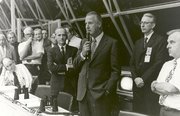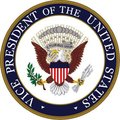Spiro Agnew
|
|
| Order: | 39th Vice President |
|---|---|
| Term of Office: | January 20, 1969 – October 10, 1973 |
| Predecessor: | Hubert H. Humphrey |
| Succeeded by: | Gerald Ford |
| Date of Birth | November 9, 1918 |
| Place of Birth: | Baltimore, Maryland |
| Date of Death: | September 17, 1996 |
| Place of Death: | Berlin, Maryland |
| Wife: | Judy Agnew |
| Profession: | Governor of Maryland |
| Political Party: | Republican |
| President: | Richard Nixon |
Spiro Theodore Agnew, born Spiro Anagnostopoulos (November 9, 1918 – September 17, 1996) in Towson, Maryland, was the thirty-ninth Vice President of the United States, serving from 1969 to 1973 under President Richard M. Nixon.
| Contents |
Early life
Spiro Agnew was born to Theodore Spiro Anagnostopoulos and Margaret Akers. His father emigrated from Greece to the United States in 1897 and owned a restaurant. He would become a Baltimore Democratic ward leader and well known in the local Greek community. His mother was from Virginia.
Agnew attended public schools in Baltimore before enrolling in Johns Hopkins University in 1937. He studied chemistry at Johns Hopkins University for three years before being drafted to join the U.S. Army and serving in Europe during World War II. He was awarded the Bronze Star for his service in France and Germany.
Prior to leaving for Europe, Agnew began working at an insurance company where he met and, on May 27, 1942, married another company employee, Elinor Isabel Judefind, known as Judy. They would eventually have four children: Pamela, James Rand, Susan, and Kimberly.
Upon his return from the war, Agnew tranferred to the evening program at the University of Baltimore School of Law, which was then a private school. He studied law at night while working as a grocer and as an insurance salesman.
Agnew received a law degree in 1947 and moved to the suburbs to begin practicing law in Towson in Baltimore County. He passed the bar in 1949.
Political career
Agnew, raised as a Democrat, switched parties and became a Republican to fit in with his Republican law partners. In 1957, Agnew first entered politics upon his appointment by Democratic Baltimore County Executive Michael J. Birmingham to the Baltimore County Board of Appeals. In 1960, He made his first elective run for office as a candidate for Judge of the Circuit Court, coming in fifth in a five-person contest. In 1961, the new Democratic Baltimore County Executive Christian H. Kahl dropped him from the Zoning Board. Agnew loudly protested and developed much name recognition.
In 1962, Agnew ran for election as County Executive of Baltimore County. He sought office in a predominantly Democratic county where no Republican had yet been County Executive in the twentieth century and only one would after he left (Roger B. Hayden). Agnew ran and as a reformer and Republican outsider. Taking advantage of a bitter split in the Democratic Party, Agnew was elected and sworn in in 1963.
Instead of a seeking a second term, Agnew decided to run for Governor of Maryland in 1966. In this overwhelmingly Democratic state, Democrats crossed party lines to elect him after the Democratic nominee, George P. Mahoney, a Baltimore paving contractor and perennial candidate running on an anti-integration platform, narrowly won the Democratic gubernatorial primary out of a crowded slate of eight candidates. Many Democrats opposed to segregation crossed party lines to give Agnew the governorship by 82,000 votes. Agnew became the fifth Republican governor in Maryland history and there would not be another until the election of Robert Ehrlich in 2002. As governor, Agnew backed tax and judicial reforms and projected an image of racial moderation during the riots that followed the assassination of Martin Luther King, Jr..
Agnew�s moderate image, immigrant background and successful political career in a traditionally Democratic state made him an attractive running mate for Nixon in 1968. Agnew�s nomination was supported by certain conservatives within the Republican Party and by Nixon, who encouraged the Republican National Convention to nominate Agnew. But a small band of delegates started shouting �Spiro Who??� and tried to place George Romney�s name in nomination. Nixon�s wishes prevailed and thus, in what was considered a meteorical rise in politics, Agnew went from his first election as County Executive to Vice President in six years.
Presidential campaigns
Agnew was known for his tough criticisms of political opponents, especially liberal journalists who he charged were guilty of advocacy journalism in the coverage, particularly of the Vietnam War. He was known for attacking his opponents with unusual turns of phrase. Among his most famous were "nattering nabobs of negativism", which his speechwriter William Safire coined, and "impudent corps of effete snobs". White House speechwriter Patrick Buchanan has been credited with coming up with "pusillanimous pussyfoots" and "hopeless, hysterical hypochondriacs of history". Agnew is also generally credited with being the first to use the term "radiclib", an abbreviation of "radical liberal".
Agnew toned down his rhetoric and dropped most of the alliterations after the 1972 general elections.
Resignation
On October 10, 1973, Agnew became the second Vice President to resign the office. Unlike John C. Calhoun, who resigned to take a seat in the Senate, Agnew resigned and then pled nolo contendere (no contest) to a criminal charge of tax evasion, part of a scheme where he allegedly accepted $29,500 in bribes during his tenure as governor of Maryland. Agnew was fined $10,000 and put on three years' probation. He was later disbarred by the State of Maryland. His resignation triggered the first use of the 25th amendment, as the vacancy prompted the appointment and confirmation of Gerald R. Ford as his successor. Ford hadn't been Nixon's first choice, however. Nixon's top three choices were Texas Governor John Connally, New York Governor Nelson Rockefeller and California Governor Ronald Reagan. Nixon thought Connally was too unpopular, and Rockefeller and Reagan unlikely to be confirmed by both Houses of Congress.
After he left the White House, Agnew became an international trade executive with homes in Rancho Mirage, California, Crofton, Maryland and Ocean City, Maryland.
Agnew died suddenly on September 17, 1996 at Atlantic General Hospital, in Berlin, Maryland in Worcester County (near his Ocean City home) only a few hours after being hospitalized and diagnosed with an advanced, yet to that point undetected, form of leukemia. He is buried at Dulaney Valley Memorial Gardens, a cemetery in Timonium, Maryland in Baltimore County.
External link
- University of Maryland's repository for all things Spiro Agnew (http://www.urhome.umd.edu/newsdesk/culture/release.cfm?ArticleID=815)
| Preceded by: Christian H. Kahl | Baltimore County Executive 1962 – 1966 | Succeeded by: Dale Anderson | ||||
| Preceded by: J. Millard Tawes | Governor of Maryland 1967 – 1969 | Succeeded by: Marvin Mandel | ||||
| Preceded by: William E. Miller | Republican Party Vice Presidential candidate 1968 (won), 1972 (won) | Succeeded by: Bob Dole | ||||
| Preceded by: Hubert H. Humphrey | Vice President of the United States January 20, 1969 – October 10, 1973 | Succeeded by: Gerald Ford
|
||||



